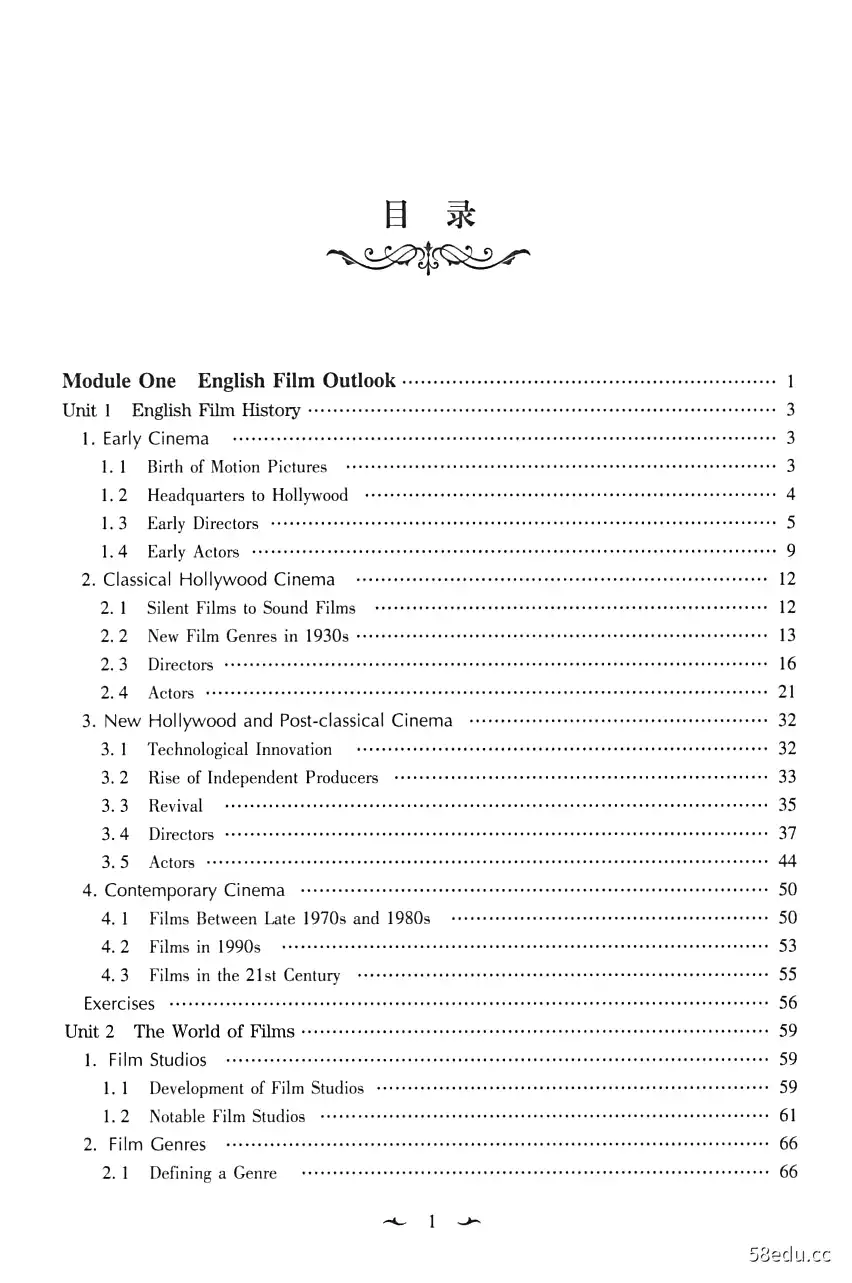《英美影视文学与文化》胡贞主编;吴玲娟,卢佼,刘青青副主编|(epub+azw3+mobi+pdf)电子书下载
图书名称:《英美影视文学与文化》
- 【作 者】胡贞主编;吴玲娟,卢佼,刘青青副主编
- 【页 数】 444
- 【出版社】 武汉:武汉大学出版社 , 2018.04
- 【ISBN号】978-7-307-19888-3
- 【价 格】59.00
- 【分 类】影视艺术-文学研究-英国;影视艺术-文学研究-美国;影视艺术-文化-研究-英国;影视艺术-文化-研究-美国
- 【参考文献】 胡贞主编;吴玲娟,卢佼,刘青青副主编. 英美影视文学与文化. 武汉:武汉大学出版社, 2018.04.
图书封面:
图书目录:


《英美影视文学与文化》内容提要:
本书分三大块(即英美影视基础知识、英美文学与影视作品、英美文化与影视作品)以英美影视作为切入口,提炼英美文化主题,并针对主体进行探讨,以期广大读者和学生更好地了解英美影视文学与文化知识,开拓视野,鉴赏影视文学与作品,提高跨文化交流、语言表达和阅读的能力。此外,可以方便广大读者在学习的过程阅读和观摩经典影视作品,掌握专业词汇,更好地在实践中理解和评介这些作品。
《英美影视文学与文化》内容试读
Module OneEnglish Film Outlook26
Unit 1
English Film History
e义9
The history of film cannot be credited to one individual as an oversimplification of any historyoften tries to do.Each inventor added to the progress of other inventors,culminating in progressfor the entire art and industry.
The history of World Cinema,to a certain degree,is a history of American Cinema,with
Hollywood interacting with a range of national and transnational cinemas,from German
Expressionism to Hollywood and Chinese films.The American film industry has dominated allothers in last and this century.
American cinema often referred to as Hollywood)has had a far-reaching influence oncinema of the world since the early 20th century.Its history is separated into four main periodsaccording to this book:the early period,the classical Hollywood period,the new and post-classical period,and the contemporary period.
1.Early Cinema
The cinema did not emerge as a form of mass consumption until its technology evolved fromthe initial "peepshow"format to the point where images were projected on a screen in a darkenedtheater.The Early Cinema Period started from 1830s to 1920s.
1.1 Birth of Motion Pictures
A recorded instance of photographs capturing and reproducing motion was a series ofphotographs of a running horse by Eadweard Muybridge 1830-1904 )an Americanphotographer.He made a pioneering series of photographs on glass plates,using twenty separatecameras placed in a row,in order to show precisely how a horse ran.Muybridge's accomplishmentled inventors everywhere to attempt to make similar devices that would capture such motion.
3
Module One English Film Outlook
Horse Jumping (circa 1877),sequential photographs by Eadweard Muybridge
In the United States,Thomas A.Edison (1847-1931)was among the first to produce such adevice,the Kinetoscope.He completed with his assistant Dickson the design of an electricallycontrolled camera,the Kinetograph,and a peep-show machine called the Kinetoscope,givingviewers the thrill and novelty of perceiving life-like movements of vaudeville performers and boxingexhibitions.The Kinetoscope was patented in 1891 and heard by an entrepreneur named Norman
Raff two years later.Under Edison's name and Raff's manufacture,the first Kinotoscope parloropened in 1894.
Edison was one of the determining figures for the early development of motion pictures as anindustry,while his French competitors,the Lumiere Brothers,had taken the lead due to theirability to project motion pictures in front of an audience.Louis Lumiere (1864-1948)invented the
Cinematograph upon Edison's design of the Kinetoscope.It combined moving images with frontprojection using intermittent movement.In contrast to early Edison's large and cumbersome
Kinetograph,the camera was portable,lightweight,and thus free from studio restrictions for easyoutdoor use as a cinematic recorder of "actualities"of life.The Lumiere Brothers had his new
Cinematograph exhibited in public for the first time in Paris in December,1895.The immediatesuccesses of the exhibition won the enthusiastic support and wonder of the public and made 1895the official birth year of the cinema as we know it today.
1.2 Headquarters to Hollywood
Competition in film industry was fierce because of the temptingly high profit.In 1908,Edisonformed the Patents Company,allied with nine other leading companies including Vitagraph,
Selig,Biograph,etc.,claiming 16 patent rights.The Company strangled all those companies notallied with them.By 1910,it had monopolized the production,distribution and exhibition in
America.To free from its monopoly,independent producers left the filming centers of New Yorkand Chicago and filmed in Hollywood,a little village several miles away from downtown Los
Angeles.D.W.Griffith shifted his filming place to Hollywood and there he made hundreds of filmsand gathered a favorable number of outstanding actors.
After the Treaty of Versailles was signed in 1919,which formally ended World War I,theAmerican film industry permanently relocated its production headquarters to Hollywood.It grew and
4
Unit 1 English Film History
prospered there between 1920 and 1929.The population in Hollywood had grown from 5,000 by 1910 to36,000 by 1920,and it would be 157,000 by 1930.The major movie studios (around twenty)werelocated in Hollywood,among which,there were the "Big Three"(Paramount,Metro-Goldwyn-Mayerand First National)and smaller studios like Warer Bros.,Fox and Universal,etc.In 1924,the Big
Three Studios consolidated their film production and distribution companies by acquiring their owntheatre chains.Zukor's Paramount Pictures absorbed a number of smaller companies.Lois Mayer and
Sam Goldwyn created MGM as the production arm for Loew's theatre chain.First National depended onindependent producers to supply films to its movie houses.
American film production gradually completed its transformation in 1920s from director-centered system into producer-centered mode.Hence came into being the "star system".Things in
Hollywood became scandalous when rumors spread on "the sins of Hollywood"which includedaccusations of depravity,sexual license and amorality among Hollywood stars.News of alleged rapeand murder of leading actors and directors such as Fatty Arbuckle and William Desmond Taylorbecame headlines on various newspapers.Fearing huge economic losses resulting from the scandals,
Hollywood decided to take measures to establish and maintain the highest possible moral and artisticstandards in film production.In 1922,Hollywood founded the Motion Picture Producers and
Distributors of America (MPPDA)and made the famous Hays Code under the host of Will Hays,which aimed to cast out the amoral plots,dialogues and scenes when censoring films.
1.3 Early Directors
Films shot in documentary style from 1895 to 1905 were not edited.Like the Lumiere films,they "rendered the world as it is"in their presentation of news stories of the day.Meanwhile,thedevelopment of fantasy films by Georges Melies,with "in-film",stop-motion editing,enabledsome directors to create "magic realism"for their fictional narratives.These films recreated theworld according to the filmmaker's imagination.Both tendencies influenced other directors in filmproduction as the demand to tell simple narratives held the interest of the audience and helpedthem identify with characters in the filmed events.
1.3.1 Edwin S.Porter (1870-1941)
Apil21,1870
Born
Connellsville,Pennsylvania,the United States
April 30,1941
Died
New York City,the United States
Occupation
Film director,film producer
Years active
1899-1915
5
Module One English Film Outlook
Filmography:Jack and the Beanstalk (1902),The Life of an American Fireman (1902),The
Great Train Robbery (1903),The Kleptomaniac (1905),Life of a Cowboy (1906),Rescued froman Eagle's Nest (1908),and The Prisoner of Zenda (1913)
To profit,moviemakers turned to dramatic stories.Though the growth of this genre was slow,some dramatic films proved exceptionally popular.Edison hired Edwin S.Porter as projectionistand director when his new studio was built in New York.Porter directed two important films,The
Life of an American Fireman (1902)and The Great Train Robbery (1903),which proved to be acomplete revolution for the narrative structure of motion pictures.
Porter built his short film narratives from the sensational stories carried by daily newspapersand skillfully reconstructed these stories into one-shot films showing one continuous action frombeginning to end staged without a moving camera.His skill in reconstructing the actions of majorcharacters had been revealed in films like Capture of the Biddle Brothers (1902)and Fun in a
Bakery Shop (1902).When directing Jack and the Beanstalk (1902),Porter imitated thestructure of theatrical story-telling that French director Georges Melies had improved.And heplayfully experimented and capitalized on the essential connection between documentary films shotin real time and studio scenes shot within a theatrical space.Therefore,he managed to expand thelinear narrative with the introduction of simultaneous actions through cross-cutting one scene witha different one.His cutting back and forth from one scene to another developed tension orsuspense within the narrative.
In Porter's The Life of an American Fireman,this editing technique was utilized to heightenthe dramatic effect of the last-minute rescue.At the start of the film,the first shots show thethoughts of a fireman through a "balloon",borrowed from comic strips.The fireman imagines hisfamily in a fire;the film then cuts to a close-up of a fire alarm and a hand pulling the alarm.
Documentary footage follows of fire fighters answering the alarm.Porter then combines thesescenes with staged events of firemen entering the building by ladder and parallel shots of thedramatic rescue of the woman and child trapped inside the burning building.In some versions ofthe film the editing of the rescue scenes shows intercutting from the exterior arrival of the firemenat the building to the interior room where fire men break down the door,creating a new narrativedimension.
In 1903,Porter made The Great Train Robbery,which took a few more steps in evolving afilm grammar.This film is one reel of action,violence,frontier humor,special effects (a veryeffective matte shot of a train passing as seen through a stationhouse window),and,as a finalfillip,a full-screen close-up of a bandit firing his pistol at the audience.Porter's camera anglestend to emphasize the realism of the exteriors.In fourteen scenes,he told a complicated at thattime)story and told it visually and vividly,with virtually no titles.The Great Train Robbery wasnot only the most famous film produced by Edison studios;it was also the single most famousAmerican movie until it was displaced twelve years later by The Birth of a Nation.The Great Train
Robbery made Porter the leading filmmaker of his day.
46
···试读结束···


